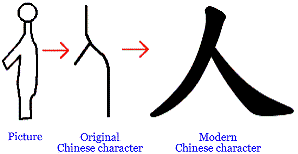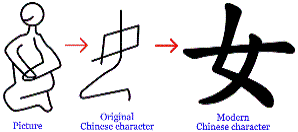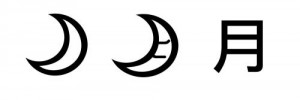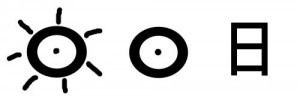What’s in a Chinese Character? (Vol. 1) Posted by sasha on Dec 2, 2011 in Culture, Vocabulary
For foreigners studying Chinese, one of the most difficult aspects can be reading and writing Chinese characters (汉字 – hàn zì), which number in the tens of thousands. Functional literacy in the language requires a knowledge of about 3-4,000 characters. If you know this many, you should be able to read a newspaper (报纸 – bào zhǐ) in Chinese. Used for thousands of years, Chinese characters are the oldest continuously used system of writing in the entire world. While they used to be written vertically from right to left, these days they are written horizontally from left to right. When studying Chinese characters, there’s also the difference between traditional (繁体字 – fán tǐ zì) and simplified (简体字 – jiǎn tǐ zì) characters. Since the 1950s, mainland China has used the simplified characters, while Hong Kong, Macau, and Taiwan continue to use the traditional style. Here’s an example of the difference between the two – China (traditional – 中國, simplified – 中国). As you can see, the character for “middle” remains the same, but the character for “country” is quite different. Either way, the name for China is pronounced the same, “Zhōng guó”, meaning “middle country.”
While studying Chinese characters can certainly be intimidating, it can also be fun, and it is definitely a good work-out for your brain. Let’s take a look at some examples of Chinese characters and where they come from:
 Let’s start with the simplest Chinese character – one (一 – yī). It is simply one horizontal stroke of the pen, and it clearly represents the number one. Well, they say that one is the loneliest number, so why not add something to it?
Let’s start with the simplest Chinese character – one (一 – yī). It is simply one horizontal stroke of the pen, and it clearly represents the number one. Well, they say that one is the loneliest number, so why not add something to it?
 That brings us to the character for two (二 – Èr). Simply add another stroke to one, and you’ve got two. Once you get beyond one stroke, you have to also consider the stroke order when writing Chinese characters. The character for two shows us that one element of stroke order is writing from top to bottom. Well, two is OK, but three’s company, right?
That brings us to the character for two (二 – Èr). Simply add another stroke to one, and you’ve got two. Once you get beyond one stroke, you have to also consider the stroke order when writing Chinese characters. The character for two shows us that one element of stroke order is writing from top to bottom. Well, two is OK, but three’s company, right?
 The character for three (三 – sān) is simply three horizontal lines. Notice that the middle line is the smallest, followed by the top line, and finally the bottom line. If only all Chinese characters were so simple! Unfortunately, they aren’t. From here on out, the characters just get more complicated. However, deciphering the meaning of other characters can be very interesting.
The character for three (三 – sān) is simply three horizontal lines. Notice that the middle line is the smallest, followed by the top line, and finally the bottom line. If only all Chinese characters were so simple! Unfortunately, they aren’t. From here on out, the characters just get more complicated. However, deciphering the meaning of other characters can be very interesting.
As Chinese characters have been around for thousands of years, many of the modern day, simplified characters have simply evolved from ancient pictographs. Take, for example, the character for person (人 – rén):
As you can see, this character has evolved over time to represent the side view of a person. It’s quite simple, and easy to understand. Here is another example, the Chinese character for woman (女 – nǚ):
 This character has evolved from a picture of a woman sitting in a traditional posture in ancient times. If you look closely, you’ll see this character used as a radical in many others. Look at the Chinese word for mother (妈妈 – mā mā), and you see that the left part of the character is the radical for woman. Makes sense, doesn’t it?
This character has evolved from a picture of a woman sitting in a traditional posture in ancient times. If you look closely, you’ll see this character used as a radical in many others. Look at the Chinese word for mother (妈妈 – mā mā), and you see that the left part of the character is the radical for woman. Makes sense, doesn’t it?
 The character for man (男 – nán) is made up of two components: on top is the character for field (田 – tián), and on the bottom is the character for power (力 – lì). Before the days of skyscrapers and big multinational companies in China, a man was someone who demonstrated his power by working in the field. Thus, we have the character for man.
The character for man (男 – nán) is made up of two components: on top is the character for field (田 – tián), and on the bottom is the character for power (力 – lì). Before the days of skyscrapers and big multinational companies in China, a man was someone who demonstrated his power by working in the field. Thus, we have the character for man.
Before we go, let’s look at two more simple examples of Chinese characters.
One of the easiest characters to learn, and also one of the most useful, is the character for sun (日 – rì). Evolving from an ancient pictograph, this characters also means day in Chinese, which makes sense, as the sun rises and sets in one day. It is used in many words, such as: birthday (生日 – shēng rì), holiday (节日 – jié rì), and Japan (日本 – rì běn). It is also commonly used as a radical. Some examples include: morning/early (早 – zǎo), star (星 – xīng), and crystal (晶 – jīng). As the light on a crystal looks so bright and brilliant, it resembles several suns, as you can see in the character, which is made up of three suns.
 If we’ve talked about the sun, we might as well talk about the moon (月 – yuè). As the moon revolves around the Earth once a month, this character also means month. In Chinese, every month of the year uses this character; the format is (number + moon). For example, January (一月 – yī yuè), February (二月 – Èr yuè), and all the way to December (十二月 – shí èr yuè).
If we’ve talked about the sun, we might as well talk about the moon (月 – yuè). As the moon revolves around the Earth once a month, this character also means month. In Chinese, every month of the year uses this character; the format is (number + moon). For example, January (一月 – yī yuè), February (二月 – Èr yuè), and all the way to December (十二月 – shí èr yuè).
By combining the character for sun with the character for moon, we get the character for bright (明 – míng). This makes sense, as both the sun and the moon are very bright.
There you go, now you’re on your way to understanding the complex written system of the Chinese language. For more help in your Chinese studies, check out the Transparent Chinese word of the day.

Build vocabulary, practice pronunciation, and more with Transparent Language Online. Available anytime, anywhere, on any device.
About the Author: sasha
Sasha is an English teacher, writer, photographer, and videographer from the great state of Michigan. Upon graduating from Michigan State University, he moved to China and spent 5+ years living, working, studying, and traveling there. He also studied Indonesian Language & Culture in Bali for a year. He and his wife run the travel blog Grateful Gypsies, and they're currently trying the digital nomad lifestyle across Latin America.





Comments:
Steven C. Poling Jr.:
You should have subsequent articles about the different scripts. (e.g.: Greater Seal Script).